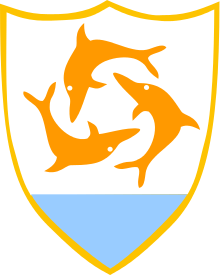Ronald Webster
| The Honourable Ronald Webster MHA | |
|---|---|
| Chief Minister of Anguilla | |
|
In office 1 May 1980 – 12 March 1984 | |
| Monarch | Elizabeth II |
| Governor |
Charles Harry Godden Alastair Turner Baillie |
| Preceded by | Emile Gumbs |
| Succeeded by | Emile Gumbs |
|
In office 10 February 1976 – 1 February 1977 | |
| Monarch | Elizabeth II |
| Succeeded by | Emile Gumbs |
| Personal details | |
| Born |
March 2, 1926 The Valley, Anguilla |
| Political party |
People's Progressive Party (1976-1977) Anguilla United Party (1977-1981) Anguilla National Alliance (1981-) |
James Ronald Webster[1] (born 2 March 1926) is a politician from Anguilla.[2] He served as the island territory's Chief Minister from 10 February 1976 to 1 February 1977 and again from May 1980 to 12 March 1984.
Prior to serving as Chief Minister, Webster was designated Chairman of the Anguilla Island Council when the territory declared its independence from the Saint Christopher-Nevis-Anguilla government in 1967, through the Anguillan Revolution which he led.[3][4] Anguillans forced the Saint Kitts officials and police off of the island, due to alleged mistreatment of the public and governmental misuse of funds (as an example, Anguilla received financial assistance from Canada to build a pier on the island; the money was sent to the central government on Saint Kitts, and a pier was built - on Saint Kitts).
In a referendum held on 11 July the inhabitants of Anguilla voted overwhelmingly to secede from the Associated State and to become a separate colony of Britain. Britain sent an advisor, Tony Lee, to exercise an "interim basic administrative authority" in conjunction with Ronald Webster, from January 1968 to January 1969; St. Kitts refused to extend the interim agreement and the British authorities left. In February 1969 islanders voted again to remain separate from Saint Kitts and Nevis and to become an "independent republic".
A British Junior Minister from the UK arrived in March 1969 to establish another "interim agreement", and was expelled within hours of arrival. Eight days later 315 British paratroopers and two frigates arrived to "restore order". Tony Lee was installed as a Commissioner for local administration.
An interim agreement in 1971 was followed by a new constitution in 1976. In 1980 Anguilla was formally separated from Saint Kitts and Nevis and became a British colony again.
Webster's birthday, 2 March, has been celebrated as a public holiday in Anguilla since its proclamation in 2010.[1]
References
- 1 2 "March 2, Public Holiday in Honour of Hon J. Ronald Webster". Anguilla News. 2 March 2010. Retrieved 5 June 012. Check date values in:
|access-date=(help) - ↑ Regional Surveys of the World: South American, Central America and the Caribbean, 10th Ed. London: Europa, 2001. 53.
- ↑ Naylor, R.T. Hot Money and the Politics of Debt. McGill-Queen's University Press, 2004. 43.
- ↑ Westlake, Donald (1972). Under an English Heaven. New York: Simon & Schuster. p. 127. ISBN 0-671-21311-3.
| Preceded by (–) |
Chief Minister of Anguilla 1976–1977 |
Succeeded by Emile Gumbs |
| Preceded by Emile Gumbs |
Chief Minister of Anguilla 1980–1984 |
Succeeded by Emile Gumbs |
